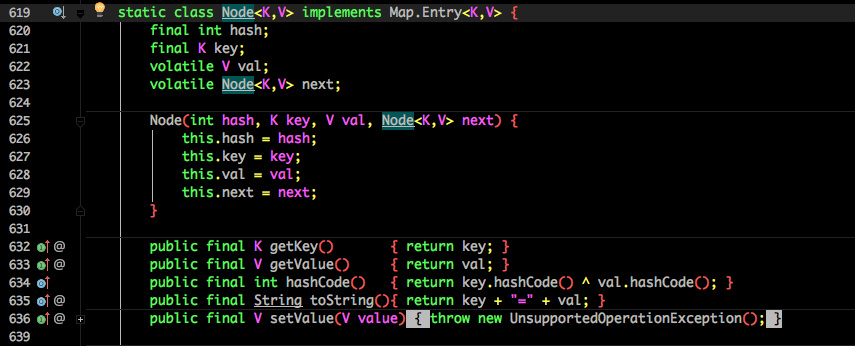https://juejin.cn/post/6937266785854947358?utm_source=gold_browser_extension
CAS + synchronized 来保证并发安全性。
Node节点

其中的 val next 都用了 volatile 修饰,保证了可见性。
初始化
public ConcurrentHashMap(int initialCapacity) {if (initialCapacity < 0)throw new IllegalArgumentException();int cap = ((initialCapacity >= (MAXIMUM_CAPACITY >>> 1)) ?MAXIMUM_CAPACITY :tableSizeFor(initialCapacity + (initialCapacity >>> 1) + 1));this.sizeCtl = cap;}// 找到1.5倍初始容量+1最近的2的n次方的值private static final int tableSizeFor(int c) {int n = c - 1;n |= n >>> 1;n |= n >>> 2;n |= n >>> 4;n |= n >>> 8;n |= n >>> 16;return (n < 0) ? 1 : (n >= MAXIMUM_CAPACITY) ? MAXIMUM_CAPACITY : n + 1;}
put
sizeCtl :默认为0,用来控制table的初始化和扩容操作-1 代表table正在初始化-N 表示有取-N对应的二进制的低16位数值为M,此时有M-1个线程进行扩容。其余情况:1、如果table未初始化,表示table需要初始化的大小。2、如果table初始化完成,表示table的容量,默认是table大小的0.75倍
final V putVal(K key, V value, boolean onlyIfAbsent) {if (key == null || value == null) throw new NullPointerException();int hash = spread(key.hashCode());int binCount = 0;for (Node<K,V>[] tab = table;;) {Node<K,V> f; int n, i, fh;if (tab == null || (n = tab.length) == 0)tab = initTable();else if ((f = tabAt(tab, i = (n - 1) & hash)) == null) {if (casTabAt(tab, i, null,new Node<K,V>(hash, key, value, null)))break; // no lock when adding to empty bin}else if ((fh = f.hash) == MOVED)tab = helpTransfer(tab, f);else {V oldVal = null;synchronized (f) {if (tabAt(tab, i) == f) {if (fh >= 0) {binCount = 1;for (Node<K,V> e = f;; ++binCount) {K ek;if (e.hash == hash &&((ek = e.key) == key ||(ek != null && key.equals(ek)))) {oldVal = e.val;if (!onlyIfAbsent)e.val = value;break;}Node<K,V> pred = e;if ((e = e.next) == null) {pred.next = new Node<K,V>(hash, key,value, null);break;}}}else if (f instanceof TreeBin) {Node<K,V> p;binCount = 2;if ((p = ((TreeBin<K,V>)f).putTreeVal(hash, key,value)) != null) {oldVal = p.val;if (!onlyIfAbsent)p.val = value;}}}}if (binCount != 0) {if (binCount >= TREEIFY_THRESHOLD)treeifyBin(tab, i);if (oldVal != null)return oldVal;break;}}}addCount(1L, binCount);return null;}
- 数组为空,初始化数组
- 如果
hash&(capacity-1)对应的位置如果为空表示当前位置可以写入数据,利用 CAS 尝试写入,失败则自旋保证成功。 - 倘若当前map正在扩容
f.hash == MOVED=-1, 则跟其他线程一起进行扩容 - 出现hash冲突,则采用synchronized关键字。倘若当前hash对应的节点是链表的头节点,遍历链表,若找到对应的node节点,则修改node节点的val,否则在链表末尾添加node节点;倘若当前节点是红黑树的根节点,在树结构上遍历元素,更新或增加节点。
helpTransfer 在扩容时候使用
final Node<K,V>[] helpTransfer(Node<K,V>[] tab, Node<K,V> f) {Node<K,V>[] nextTab; int sc;if (tab != null && (f instanceof ForwardingNode) &&(nextTab = ((ForwardingNode<K,V>)f).nextTable) != null) {int rs = resizeStamp(tab.length);while (nextTab == nextTable && table == tab &&(sc = sizeCtl) < 0) {if ((sc >>> RESIZE_STAMP_SHIFT) != rs || sc == rs + 1 ||sc == rs + MAX_RESIZERS || transferIndex <= 0)break;if (U.compareAndSwapInt(this, SIZECTL, sc, sc + 1)) {transfer(tab, nextTab);break;}}return nextTab;}return table;}
initTable 初始化数组时候使用
private final Node<K,V>[] initTable() {Node<K,V>[] tab; int sc;while ((tab = table) == null || tab.length == 0) {if ((sc = sizeCtl) < 0)Thread.yield(); // lost initialization race; just spinelse if (U.compareAndSwapInt(this, SIZECTL, sc, -1)) {try {if ((tab = table) == null || tab.length == 0) {int n = (sc > 0) ? sc : DEFAULT_CAPACITY;@SuppressWarnings("unchecked")Node<K,V>[] nt = (Node<K,V>[])new Node<?,?>[n];table = tab = nt;sc = n - (n >>> 2);}} finally {sizeCtl = sc;}break;}}return tab;}
- 如果ssizeCtl<0,说明有别的数组进行初始化操作
- 使用CAS修改sizectl的值为-1,表示本线程正在进行初始化
- 如果sizectl>0,则说明构造函数里面传入了初试容量,按这个值进行初始化容量
- 按默认16进行初始化
- 修改sizectl使其成为0.75倍的容量大小
- 返回数组
hash
static final int HASH_BITS = 0x7fffffff; // usable bits of normal node hash 31个1static final int spread(int h) {return (h ^ (h >>> 16)) & HASH_BITS;}int index = (n - 1) & hash // n为bucket的个数static final <K,V> Node<K,V> tabAt(Node<K,V>[] tab, int i) {return (Node<K,V>)U.getObjectVolatile(tab, ((long)i << ASHIFT) + ABASE);}
采用Unsafe.getObjectVolatie()来获取,而不是直接用table[index]的原因跟ConcurrentHashMap的弱一致性有关。在java内存模型中,我们已经知道每个线程都有一个工作内存,里面存储着table的副本,虽然table是volatile修饰的,但不能保证线程每次都拿到table中的最新元素,Unsafe.getObjectVolatile可以直接获取指定内存的数据,保证了每次拿到数据都是最新的。
get
public V get(Object key) {Node<K,V>[] tab; Node<K,V> e, p; int n, eh; K ek;int h = spread(key.hashCode());if ((tab = table) != null && (n = tab.length) > 0 &&(e = tabAt(tab, (n - 1) & h)) != null) {if ((eh = e.hash) == h) {if ((ek = e.key) == key || (ek != null && key.equals(ek)))return e.val;}else if (eh < 0)return (p = e.find(h, key)) != null ? p.val : null;while ((e = e.next) != null) {if (e.hash == h &&((ek = e.key) == key || (ek != null && key.equals(ek))))return e.val;}}return null;}
- 根据计算出来的 hashcode 寻址,如果就在桶上那么直接返回值。
- 如果是红黑树那就按照树的方式获取值。
- 就不满足那就按照链表的方式遍历获取值。

